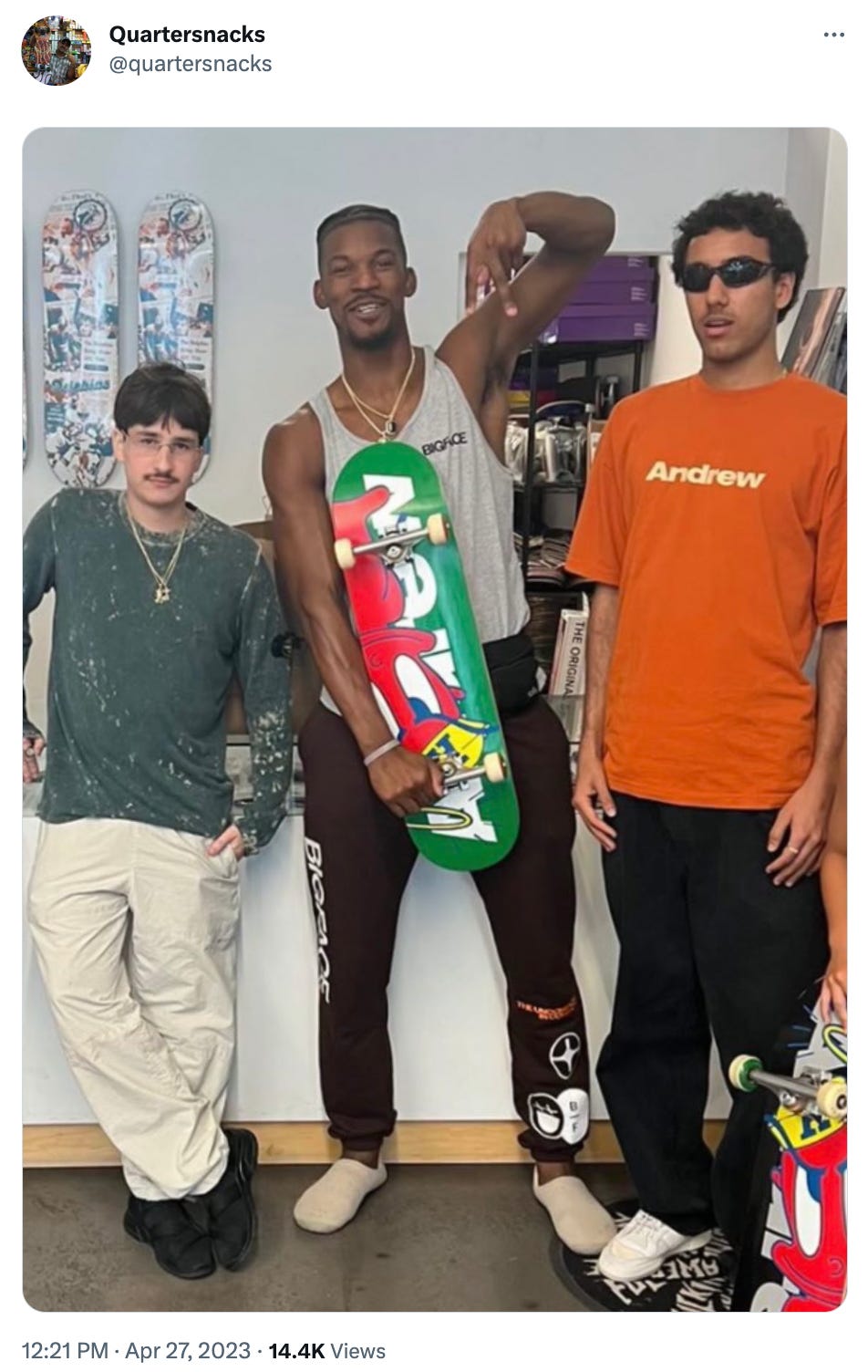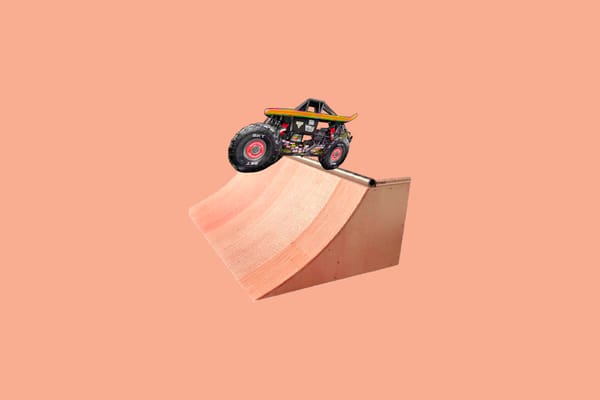A secret fourth thing
Plus: Una's pro, Alexis' pro shoe exhibition, a duplicitous nostalgia campaign, and more.

The definitive weekly ranking and analysis of all the skateboarding and other online things that I cannot stop consuming and how they make me feel, personally.

Una! Pro!
Rank: 1
Mood: 🎊🛹 🎉🛹🎊🛹 🎉
Victoria, BC’s own and Simple Magic’s #4 pound-for-pound four-eyes, Una Farrar, is officially PRO for Krooked Skateboards. While some (myself included) thought that moment might come after the release of her excellent Don’t Stop video part back in January, it would only be a few months later that the rising star in Farrar would get the nod.
The classic PRO surprise took place at Frogpark in Los Angeles with a whole whack of Vancouver locals, legends, and Farrar’s family making the journey down to celebrate. There were balloons, flowers, a skateboard-shaped piñata, and many, many friends there to cheer on the new PRO. As a viewer, these moments still remain special no matter how many instances of someone becoming PRO AF I’ve witnessed through my phone screen. It’s the culmination of a skater’s hard work, dedication, and a payoff for our continued fandom.
This shit rules. Congrats, Una.

The best-laid plans of éS and men
Rank: 2
Mood: ⏳👟👟⌛️
A “native” marketing campaign can be a fascinating thing to witness unfold. The premise itself is based purely on deception, the marketeer and their partners working to make you think what you’re seeing is a natural, “organic” endorsement of a product. Advertorials, #sponsoredcontent, corporate astroturfing — however you look at it, once you spot it, you become attuned. A sensitivity develops. You realize it’s everywhere, and suddenly you’re “Rowdy” Roddy Piper in They Live, witnessing the deceit of the world you thought you knew through newly trained lenses.
When Arto Saari’s nostalgia-inflected Instagram post about his days simultaneously filming for éS Footwear’s Menikmati and Flip Skateboard’s Sorry floated across my feed last week, my senses immediately flared.
Back in 1999-2001 I was filming for two video parts at the same time, @esskateboarding #menikmati and @flipskateboards #Sorry .My carcass can’t handle this kinda abuse anymore these days but this feeling is imprinted in my mind forever. Your equipment plays a big role when it come to skating stairs or rails.You want the ultimate board feel and protection,it’s a fine balance.I think it’s safe to say I did some of my best rides in Accel’s.
While the historical element at play is undoubtedly interesting and deserving of public self-reflection, no normal person speaks like this of their own volition. Your equipment plays a big role when it [comes] to skating stairs or rails. You want the ultimate board feel and protection, it’s a fine balance. Okay? It seems the tagging of éS and Flip may have been a bit of misdirection, but “I did some of my best rides in Accel’s” made it clear: this wasn’t Arto; it was an ad.
I went to Arto’s Instagram profile and saw that his previous post was also Accel-related, just more subtle.
One of my OG favorite skate shoes by @esskateboarding via @skateshoearchives @ludgeraundrup
This one could have understandably flown under the radar. Saari doesn’t mention his “OG favorite” shoe model by name and has taken the image from the @skateshoearchives Instagram account, which could lead the viewer to believe that this post was an innocent jaunt into the past. But the Accel posts kept coming. Saari even seemed to have lost interest in keeping up the charade just a few days into the campaign, the penultimate post before the big reveal captioned only “éS #Accel.”
Then, as most of us have come to accept, the genuine is unsustainable online. Instagram’s atmosphere is devoid of the precious oxygen earnestness needs to survive. As such, the nostalgia Saari trailed behind himself like breadcrumbs would ultimately lead to this:
Hot off the press… Accel OG X Arto dropping later this year. Contact your local skate shop for availability. Mega mahalos to @esskateboarding for drawing out inspiration from the past and releasing this collabo in 23.Time to take a trip down the memory lane to early 2000’s. 🤙🙌🙏
And you know what? Sure, why not.

Fear, awe, and the switch gawd
Rank: Also 1
Mood: 😧😳😍
A goal of photography is often cited as capturing the humanity of a moment. To be able to look back at a flat image and feel the dynamic emotional landscape of that space in time. That space and time retrofitted and recontextualized with the vision of the photographer. It’s a way to communicate feeling across generations—a tool for preservation and veneration.
With skateboarding as a subject, each photograph is an act of capturing a hurried ghost; the trick is a rush of flesh and will and wood that strains to work as one, never existing in complete form for long, passing through the composition’s net as air, frustration, joy. If the photographer is successful, the results can be multitudinous. Untold hours of my youth were spent flipping through skateboarding magazines, cycling between awe, reverie, and confusion at the tricks on the page and the cultural importance of the unearthly courage and skill it took to make them. It’s a reaction that persists to this day. Grant Britain can hard post his classic shot of Tod Swank pushing into the shadows on Instagram as often as he likes and I’ll always stop scrolling to admire.
The magazine cover has always been the station of highest regard for the photograph in traditional print media. In skateboarding, it’s usually an indicator of what on-board maneuver defied expectation — as the gnarliest or best looking — that month. Landing a cover can define a professional skateboarder’s career and legacy. Even as print media continues to be routed by the blundering hand of digital, the reverence for the magazine cover still holds. Thrasher, whose covers used to be haphazardly splashed with copy promoting the articles its issues held, resulting in a tabloid-esque visual cacophony, now rarely, if ever, has any text on its covers besides their word mark, choosing to let the photograph and its impact breathe. Newer print projects like Golden Hour and Closer luxuriate in that reverie for the photograph, from their often experimental and always captivating covers, multi-page photo spreads, to the high-quality paper their magazines are printed on.
There isn’t a set formula for what makes a compelling skateboarding magazine cover, but there are a couple of ingredients that always go well either separately or together: artistry and fear. If the photographer can capture a death-defying stunt as a work of art, that universal sense of awe we feel when seeing it is magnified ten-fold (a scientific approximation). Closer’s latest cover, shot by Kyle Siedler, of Ryan Lay doing a switch 50-50 many stories above the ground is as shocking as it is beautiful.
It’s the type of photo that might cause the viewer to gasp, stare, mouth agape, in fear and admiration. Being caught among those swirling feelings can reduce said viewer to a basal form — the ultimate power of the photograph — where the only words that come to mind are pretty. Scary.

A secret third thing
Rank: 3
Mood: ❓ ❔❓

It’s good. It’s very, very good. The skateboarding, the filming, the song, the edit. In fact, it’s better than good; it’s great. Awesome, even. If you felt inclined, as I do right now, you could call it a stunning achievement. Mason Silva and Ryan Lee have once again done it, releasing Take a Lap, a video part comprised of tricks that feel leagues beyond what we normally witness take place on a skateboard. Lee, as masterful as he’s become behind the camera and in the editing booth, makes all of the disparate moments he’s captured feel cohesive, animating an aggregation of maneuvers in a way that makes them alive and full of meaning.

This, in all likelihood, will be a video part we look back at come November and wonder if it puts Silva in contention for that heavy bronze statue Thrasher doles out. However, at least in terms of the online chatter I encountered (another scientific measurement, I’m sure), what seemed to get people most excited this week, far beyond another groundbreaking video part from a former and potentially future Skate of The Year, was the return of Hyun Kummer, otherwise known as Versace Plug.

After nearly two years away (apparently due to injury), the Instagram sensation returned to the platform with a clip featuring just two tricks done at a skatepark and edited in typical Versace Plug fashion. The post’s comment section is jubilant, with PROs and Joes alike celebrating him as a returning hero, the second coming of our viral deity. It’s an interesting dichotomy between the traditional skateboarding industry and — for lack of better phrasing — the secondary market of Instagram skateboarding influencers. If metrics are to be measured, Plug has nearly 530,000 followers on Instagram, nearly double that of Silva, meaning his organic online reach, the thing sponsors covet, is far superior. However, while Plug is also a very talented skater, he’s not SOTY level.
Between skill and marketability, is there a trait that matters more in an industry whose whole purpose is to sell hard and soft goods? There’s never been a clear answer; the two coexist to certain degrees and varying ratios, mainly at the whims of a brand’s marketing strategy. Over the years, we’ve seen the Ali Boulalas and Lizard Kings of the world — skaters whose personalities buoy them as much or more than their on-board abilities — considered on par with top-tier PROs for their ability to move the needle and product. It’s a tale as old as time: people like buying things repped by people they like. Looking at you, Shaq-endorsed EPSON ET-2760 printer sitting on my shelf.
While that dynamic has changed somewhat since the advent of social media, as marketable characters can now be self-realized instead of with a concerted industry push; Plug’s fanbase, as skewed and fleeting as an online figure’s can be (I can remember a time when he was reviled for clogging up Instagram’s “Explore” page), would seem to have significant short-term value to capitalize on. Yet, he doesn’t appear to have any big-name sponsors willing to do so. On the other hand, Mason Silva, for all of his achievements and next-level abilities, at the time of writing this, still hasn’t been given a pro-model shoe on Nike, which is generally considered the apex of PRO-dom, a space it’s clear he’s reached, and deservedly so.
That leads one to wonder, does anything matter anymore? Is there a secret third thing besides skill and marketability that’ll open those sponsors’ purse strings? Is it as simple and excruciating a thing such as time?

Or is it a secret fourth thing?
Rank: 4
Mood: ❓ ❔❓ ❔
Converse Cons recently debuted the AS-1, Alexis Sablone’s signature shoe. Not only is it a fantastic-looking silhouette, but Cons celebrated the occasion by renting out the goddamn Guggenheim for its launch party. From her days romping around Boston with PJ Ladd, her work as an architect and illustrator, her Olympics run, and a crossover appeal that’s seen her interviewed everywhere from GQ, The New York Times, to Real Sports with Bryant Gumbel on HBO, Sablone has always had it. Skill, marketability, and decades’ worth of time spent grinding in an industry that mostly refused to acknowledge the women in it until quite recently.
But Sablone is rich in another trait that exists outside the others yet permeates them all; she is cool as hell. You can be good at skateboarding, but can you make it look cool? A person can have a marketable personality, but that doesn’t mean it’s based on any level of coolness; the YouTubing Paul brothers are “marketable personalities,” but those personalities themselves are repellent. And to remain consistently cool for such an uninterrupted period of time is a Herculean feat.
Perhaps thanks to her background in architecture, Sablone has managed to build a structurally sound career out of all of these things, and it’s worthy of exhibition.

Something to consider:

Good thing: If you live in or around Vancouver, DOXA Documentary Film Festival kicks off next week, and this year’s program is, as per usual, a banger.
Another good thing: Jimmy Buckets turning Super Saiyan this week.

A Waxing the Curb returns thing: Sam Korman with a great profile of Ishod over at Waxing the Curb.
A typically good David Roth thing: “Who Could Mistake Tucker Carlson For Anything Else?” by Roth for Defector.
Until next week… if the sun decides to show itself this weekend, go outside and feel its warmth. Take a walk. Run to the corner store. Return your overdue library book. Fix that flat tire on your bicycle. Mow the lawn. Visit a body of water and while there, find a large rock, lift it over your head, scream, and throw it into the drink. That rock embodies this past week’s worries and stressors, which are now sinking into the deep, far away from you and where you want to be.






